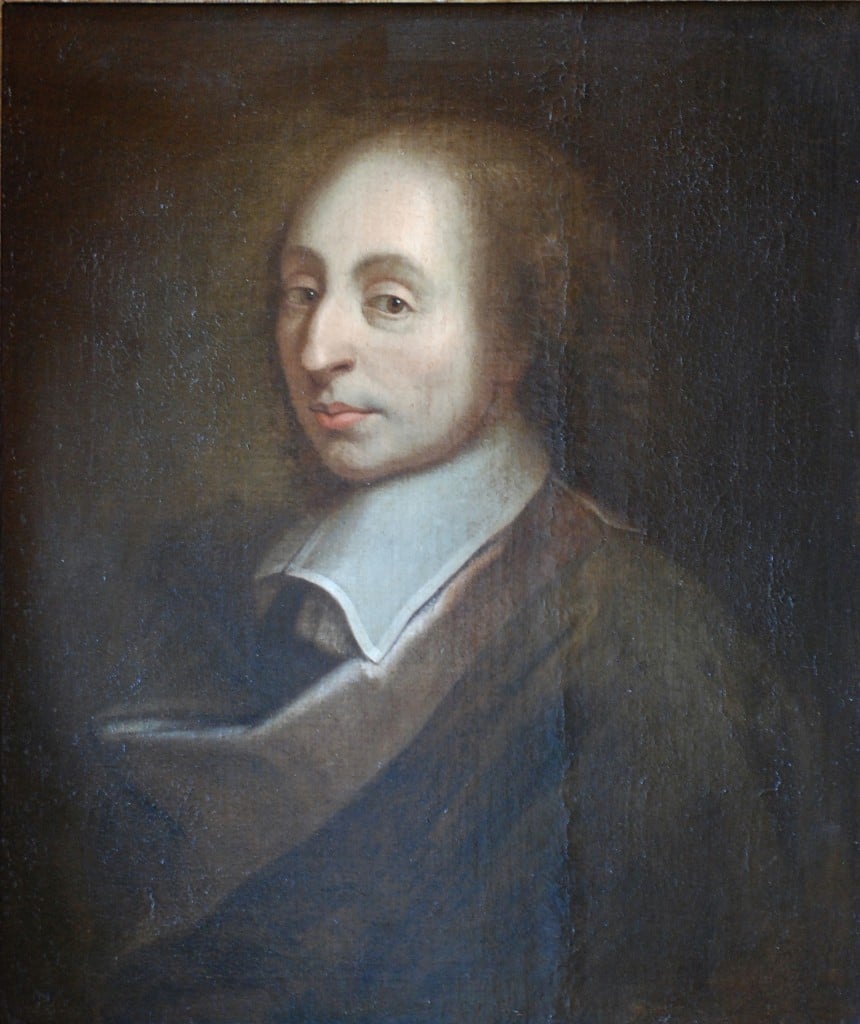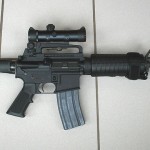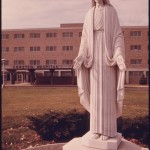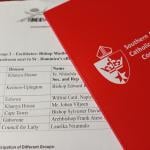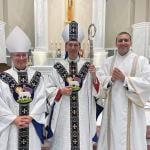
As you may know, today is the Feast of the Exaltation of the Holy Cross. I found a pretty good short piece on the finding of the Holy Cross over at Magnificat. But as usual, I went looking for more. Whoa…Mr. Spielberg? I’ve found material for your next project. This would make an epic screen play! Take a look.
from The Finding of the Cross by Louis de Combes,
excerpted from Chapter IV, “The Recovery of the True Cross”
We have no means of deciding whether Helena’s starting-point for her pilgrimage was Rome or Nicomedia, or whether she travelled alone, or in the company of her son when he transferred his capital to the East. But it seems more probable that, in order to take on board her escort, to obtain the papers authorising her to take possession of the land she required, and also the vast sums of money necessary for the work, she must have first paid a visit to Nicomedia. Hence the date of her voyage to the East was not much later, if at all, than the voyage of Constantine alluded to above.
De Vogiie, Guerin, Toupin, Rohault de Fleury, and Couret believe that she reached Jerusalem in December 326. De Broglie and Duruy contend that this happened in January 327. In spite of her great age—she was then in her eightieth year—the empress performed the journey without difficulty, escorted by the soldiers, and followed by wagons loaded with coined silver.
As soon as Macarius (bishop of Jerusalem) heard of her arrival he convoked all the bishops of the province, and went to meet her, receiving her with all due honours; in fact, with a pomp entirely without precedent, especially then, when the era of the martyrs had only just finished. The preparations made by the officials were nothing in comparison with the imposing procession of ecclesiastics and virgins which Macarius had marshalled to meet the empress mother.
Sr. Helena, Empress M. Couret has given a striking description of the meeting:
“Wherefore all this stir in Jerusalem, why this commotion under the somber vaults of the bazaar, why do some look sad, and why do the Christians—Greeks and Syrians—all wear a look of joy; what is there to frighten the little colony of Jews established outside the walls in the dirty Galilean quarter? What cause brings out the Roman tribune, at the head of his horsemen and of the Palestine garrison, and the curator reipublicce preceded by his ushers, and wherefore do they all hasten towards the Damascus Gate ? And why does the bishop Macarius, wearing the pallium which Constantine had given him, and followed by his clergy and the bishops of the province, direct his steps by a different road towards the same point?”
“Hear you not, in the direction of the same Damascus Gate, where the Roman road with its slippery stones descends through the midst of the broken vale which divides Scopus from the Mount of Olives, hear you not the clear and joyful note of the silver trumpets sounding forth their arrival? Already through the clouds of dust we can catch a glimpse of the gilt and silver breastplates of the imperial guards escorting an ivory litter hung round with purple curtains. Before this litter even the tribune lets fall the point of his sword, and bends his knee, whilst, on the other side, the golden cross is lowered, the thuribles belch forth their fragrant fumes, the choir-boys scatter handfuls of flowers, and the bishops with their deep musical voices intone the Alleluia of the days of gladness.”
At last the procession comes to a standstill, the eunuchs draw back the purple curtains and open the door, and a woman steps out; she is aged, pale, dressed in mourning, and her face, which once had been beautiful, shows traces of great sorrow. She kneels before thebishop of Jerusalem and begs his blessing. This is the Augusta.
After exchanging a few words, in spite of her great fatigue she begged Macarius to lead her to the terrace above the Holy Places. Then the procession resumed its way, entered the city, and proceeded along the long, cold, classical colonnade of the pagan city built by Adrian; soon they reached the platform. “There,” writes M. Couret, “stood a sacred grove stocked with dark-hued trees, with its tall cypresses and umbrella-shaped cedars, with pointed firs, and fragrant acacias covering with their accursed shade the two pagan chapels dedicated to Jupiter and Venus.”
Helena alighted from her litter at the sight of the goddess of love displaying her naked charms to the eyes of all. Her only thought was of the sacred treasures buried far beneath. Instinctively she felt that she was called to play a high part, and, as if inspired, she spoke thewords of which Ambrose has preserved the memory:
“Here indeed is the battlefield, but where are the trophies of victory? I seek the Standard of Salvation, and I find it not. Shall I then reign whilst the Saviour’s Cross lies in the dust? Shall I be glorious whilst the sign of Christ’s victory is buried in the earth? . . . Demon, wherefore didst thou hide this wood, save to be vanquished once again? Yea, thou shalt be made to bite the dust, and today a woman will bring thy tricks to naught. As Mary bore the Lord, so I shall discover His Cross. She manifested her child by giving him to the world; I, for my part, shall teach His resurrection.”
frescoes at the Church of San Francesco, Arezzo According to tradition, Helena forsook the sumptuous apartments prepared for her, and went to shut herself in a convent of nuns, in a bare-walled cell, whose only furniture was a wooden pallet, doubtless somewhere on the Sion hill, for there it was that monasteries were first established. Now that she had at last reached Ælia, whose foundation was laid on Holy Jerusalem, she and the bishop proceeded to make themselves ready for their mission by retirement, by fasting, and by ardent prayer, for it must not be forgotten that Helena and Macarius had pledged themselves to perform a work in which they could expect no human aid. Calvary and the sepulchre were indeed not difficult to find, for their position was known by all, but where was the Cross?
Some secret presentiment led Macarius to seek for it near the spot covered by the temple of Venus; moreover, he felt that, in spite of all the precautions taken by Annas and Caiphas, the Jews who had helped to bury the crosses could not have failed to leave behind them some record of their act. Hence when he called a council he invited to it not only all those Christians who were esteemed for their learning and sanctity, but also a few well-known Jews. The Hebrews gladly accepted his invitation, and they brought with them a rabbi hailing from the far East, who had among his family papers the very information which was sought. According to Gregory of Tours his name was Jude or Judas, and he afterwards became a convert, receiving at his baptism the name of Quiriacus. This same Cyriacus or Quiriacus soon became the hero of a marvelous legend, of which more anon. The faithful also did their best to ensure God’s help, by which man’s work might be supplemented; they sought for signs from heaven and scanned their dreams for revelations.
Then the real work was started, the inhabitants of the city lending a helping hand to the legionaries. Meanwhile the empress stayed near the works, usually sitting on a marble chair, which was for long afterwards shown at Jerusalem. Other pilgrims, however, consider this chair as that of St. James. Occasionally the workmen grew weary, and complained of the fruitlessness of their efforts, but as soon as they saw the empress throwing herself on her knees in the dust they would resume their labor with new zest.
St. Helen Testing the True Cross,
by Tinterro, c. 1545Day and night the work went on. The removal of a mass of masonry 20 feet deep by 300 feet long is not the work of a single day. Instead of starting from the east, where the grotto of Joseph of Arimathaea lay hid, the workmen, following either the instructions of Judas or the revelations of Helena and Macarius, sought at the western end of the platform for the opening of the cistern, which finally they found.
Only a few men could now work at once, but without intermission they labored at the task of extracting the rubbish and the stones which filled the narrow neck. Lower and lower went the diggers, with no result. At a depth of some twenty feet the tunnel widened out. The workmen now found themselves in a spacious cave; but was this all? Was this then the bottom, and had all hope been lost? Would the dreams of Helena and Macarius and the documents of Judas all prove false?
By sounding the walls of the cave , a passage was at last found leading even lower, and work began anew. According to tradition the empress now took up her abode in the first cave, and there continued to pray amidst the rubbish. In remembrance of this the chapel now bears her name. At last the picks struck on wood, and soon three crosses were brought to light, and also a tablet bearing on it the inscription recorded in the Gospels.
From this point onward we are confronted by a double tradition. According to St. Ambrose the true cross was distinguished from the crosses of the thieves by its title. Helena sat herself down before the three crosses, and opened the Gospels. One of the crosses bore a script nailed to it, on which was written: “Jesus of Nazareth, King of the Jews.” The chief priests had said to Pilate: “Write not ‘The King of the Jews,’ but that he said I am the King of the Jews,’ and Pilate answering had said,’ What I have written, I have written.'”
The Title? St. Ambrose considers Pilate’s reply as a real inspiration, for it means: “I have written not what pleases you, but what future ages will wish to know. I wrote, not for you, but for posterity; as if he had written this expressly that Helena might read and recognize the cross of her Savior.” We must remember that Theodosius had taken Ambrose into his confidence, and that no one was better placed for ascertaining the truth.
St. John Chrysostom gives a similar version: “It was to come to pass that the True Cross should be sought for, that the three crosses should be confused, and that the Cross of Christ should be recognized first by its being in the center, and secondly by its bearing a title.”
If it were true, as some others of the Fathers relate, that Christ alone was nailed to His cross, whereas the thieves were only tied to theirs, then the choice would have been easier. The True Cross would then have been recognized by the holes made in it by the nails.
The Bollandists and the majority of early chroniclers hold that the Cross was identified by means of a miracle. According to Sozomen it was at first impossible to tell which of the three crosses was the true; the title was indeed in the cavern with the crosses, but it had been detached. Now at that time a certain high-placed lady of Ælia was lying at death’s door. She was a widow, Libania by name, who had been born a Jewess, but who after the death of her husband Isachar had forsaken the Synagogue. Macarius on seeing the general anxiety exclaimed: “Bring away all the crosses, and let God show that of the Savior.” Followed by Helena and the crowd, he proceeded to the house of the dying lady, fell on his knees, and prayed as follows:
O Lord, who by the Passion of Thine only Son on the cross, didst deign to restore salvation to mankind, and who even now hast inspired thy handmaid Helena to seek for the blessed wood to which the author of our salvation was nailed, show clearly which it was, among the three crosses, that was raised for Thy glory. Distinguish it from those which only served for a common execution. Let this woman who is now expiring return from death’s door as soon as she is touched by the wood of salvation.
She was touched with one and then with another cross, but to no avail, but as soon as the third was presented she opened her eyes, and arose, and feeling herself even more alive and vigorous than when she had been in health, she began to run about the house glorifying God’s almighty power.
We now return to the cave. Helena, the true cross being now revealed, fell on her knees, but felt drawn between two—hesitating between her desire to kiss the holy relic and her fear of committing a sacrilege in touching it with her lips. At last she…
Sorry for the teaser, but you’re going to want to read the rest…I guarantee it. And all of the footnotes too.
Update:Fr. Steve Grunow of Word on Fire (check out his homily!) sends:
Frank, have you ever read Evelyn Waugh’s Helena, which is his novelization of the conversion of St. Helena and her pilgrimage to retrieve and enshrine the relics of the crucifixion? It is a great read and would be a fine basis for a screenplay.
Did you hear that Mr. Spielberg? Time to throw another book on the nightstand!
p.s. I read Helena, and posted on it here. It is a great book.






